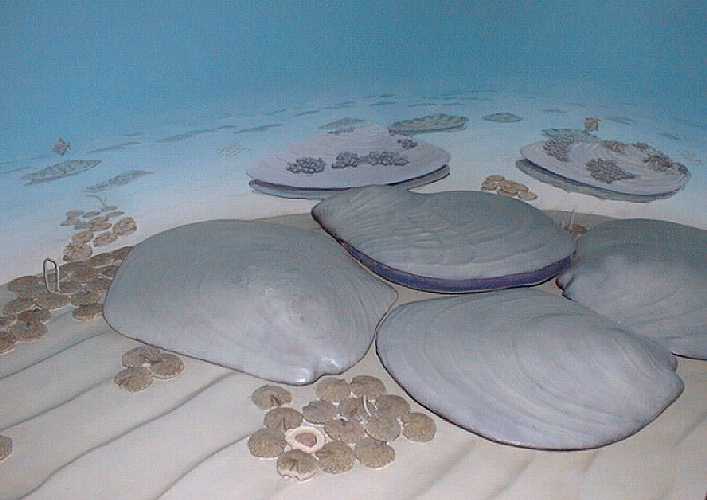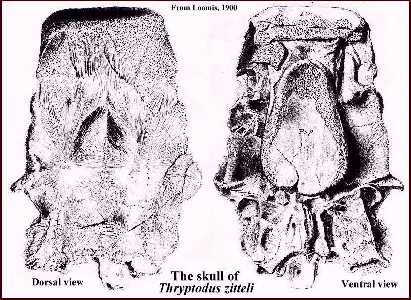 |
Thryptodus zitteli
The "Battering Ram" Fish
An Unusual Fossil from the Smoky Hill Chalk of Western
Kansas
Copyright © 1999-2017by Mike Everhart
Last Updated 03/02/2017
LEFT: A diorama at the Sternberg
Museum showing the floor of the Western Interior Sea during the Late Cretaceous. The large
inoceramid clams are Platyceramus platinus; the smaller bivalves are rudists
called Durania maxima. Two small pycnodont fish are visible in the background. |
Fossils have been collected
from the Smoky Hill Chalk and Pierre Shale of western Kansas since
the late 1860s. There have been many spectacular fossils found, including long necked
plesiosaurs (Elasmosaurus platyurus), giant fish (Xiphactinus), mosasaurs and pteranodons. These are well known and can be readily
identified. Many of these fossils are shown on the Oceans of Kansas Paleontology web
pages. Some remains, however, like the two specimens shown below are more difficult
to identify (and explain!).
These two fossils shown below are
examples of the anterior part of the skull (ethmoid and premaxillae) of a strange fish
called variously Bananogmius zitteli (Cope) and Thryptodus zitteli(Loomis). Thryptodids belong to an extinct family of fish called plethodids, which
includes another species commonly found in the chalk: Bananogmius evolutus.
Note that Taverne (2001) recently removed B. evolutus (Cope 1878) from the genus Bananogmiusand placed it into a new genus (Pentanogmius Taverne 2000) as Pentanogmius
evolutus (Cope 1878).
For this page, I will use Thryptodus until I can work out
the most correct name. Thryptodids were a primitive group of fish that do not have
modern relatives as far as I am aware. In some cases, like Thryptodus and Martinichthys, their skeletons were poorly ossified and
were rarely preserved.
 |
LEFT: Complete
skulls of Thryptodus have been found rarely in the chalk. The type specimen
of Thryptodus zitteli (from Kansas and described by Loomis, 1900) was in a museum
in Germany that was destroyed by Allied bombs during World War II. In Kansas, these
fish are only found in the lower 1/4 of the Smoky Hill Chalk and apparently become extinct
by the end of Coniacian time (about 86 mya).
More recently, Shimada and Schumacher (2003) described what is
probably the oldest specimen of Thryptodus (FHSM VP-13996) from the Lincoln Limestone (Middle Cenomanian) Member of the Greenhorn
Limestone Formation in Russell County, KS. |
Unfortunately, the two specimens shown
below are the best that I have found so far. The skull of Thryptodus was
heavily built, with a rostrum (the ethmoid bone, shown below) that is very massive.
Another unusual feature is the flat surface at the anterior end (to make the third
picture, the two 'noses' were simply stood on their ends) that shows possible wear. I
would certainly be interested in hearing about any modern analogs to this fish, or ideas
as to what the unusually heavy construction of the skull was used for. Another fish
in this family (also from the Chalk) is Martinichthys....
which also had a heavy rostrum (nose), but one which was more slender and generally showed
signs of 'wear' on the anterior end.
 |
A dorsal view of two 'noses' of Thryptodus zitteli (FHSM
VP-15571 / EPC 1995-34 and FHSM VP 15572 / EPC 1999-01), The anterior end is at the bottom
of the scan. The size of the two fish must have been about the same. |
 |
A ventral view of the same two specimens. Both of these
specimens had other skull material and vertebrae associated with them, including a large,
flat parasphenoid bone that covered the roof of the mouth. |
 |
The 'business end' of the two specimens showing the flat surface
of the 'nose'. What were these 'battering ram' like adaptations used for? Three
views of a recently discovered Texas specimen are shown HERE,
HERE, and HERE.
Based on specimens I have seen recently from Texas, the species seems to be more common
there. |
Other
Oceans of Kansas webpages on Late Cretaceous fish:
Field Guide to Sharks and Bony
Fish of the Smoky Hill Chalk
Sharks:
Kansas Shark Teeth
Cretoxyrhina and Squalicorax
Ptychodus
Chimaerids
Bony Fish
Pycnodonts and Hadrodus
Plethodids:
Pentanogmius
Martinichthys
Thryptodus
Bonnerichthys
Protosphyraena
Enchodus
Cimolichthys
Pachyrhizodus
Saurodon and Saurocephalus
Xiphactinus
Suggested references:
Loomis, F. B., 1900. Die anatomie und die
verwandtschaft der Ganoid- und Knochen-fische aus der Kreide-Formation von Kansas, U.S.A.
Palaeontographica, 46: (partial copy)
Shimada, K. and B. A. Schumacher. 2003.
The earliest record of the Late Cretaceous fish, Thryptodus (Teleostei:
Tselfatiiformes), from central
Kansas. Kansas Academy of Science, Transactions 106(1-2):54-58.
Taverne, L., 2001. Révision du
genre Bananogmius (Teleostei, Tselfatiiformes), poisson marin du Crétecé
supérior d'Amérique du Nord et d'Europe. Geodiversitas 23(1):17-40. (Revision of the
genus Bananogmius (Teleostei, Tselfatiiformes), marine fish from the Upper
Cretaceous of North America and Europe).
Taverne, L. 2003. Redescription critique des genres Thryptodus, Pseudothryptodus et Paranogmius, poissons marins (Telostei,
Tselfatiiformes) du Crétecé supérior des Etats-Unis d’ Egypte et de Libye. Belgian Journal of Zoology 133(2):163-173.






